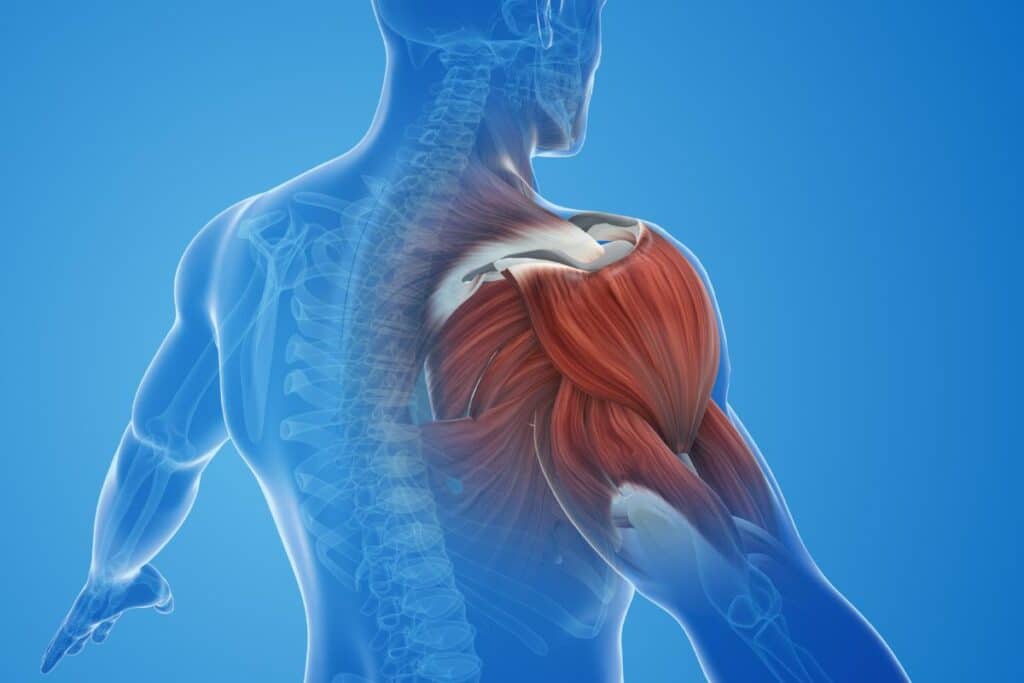Muscle plays a pivotal role in health and fitness that extends far beyond its contribution to physical appearance. The significance of muscle mass in our overall health, physical fitness, and quality of life cannot be overstated. This article delves into the multifaceted impact of muscle on health and fitness, underscoring the importance of incorporating strength training into our fitness regimen.
Understanding Muscle: Composition and Functionality
The muscle is a vital tissue in the human body, essential for movement and maintaining posture, generating heat, and facilitating circulation. This article delves into muscle tissue composition, its types, and the intricate processes that enable muscles to function, providing a comprehensive overview of muscle anatomy and physiology.
The Composition of Muscle Tissue
Muscle tissue is composed of cells known as muscle fibers, which are unique in their ability to contract or shorten, producing movement or force. These fibers are bundled together in a protective sheath, forming a muscle. Each fiber contains myofibrils, further divided into sarcomeres, the basic functional units of muscle contraction. Sarcomeres are composed of two main types of protein filaments: actin (thin filaments) and myosin (thick filaments). The interaction between these filaments is fundamental to muscle contraction.
Types of Muscle Tissue
The human body contains three types of muscle tissue, each with distinct functions and characteristics:
1. Skeletal Muscle
Skeletal muscles are attached to bones and are responsible for voluntary movements, such as walking or lifting objects. These muscles are striated, meaning they have a banded appearance due to the organized arrangement of actin and myosin. Skeletal muscle fibers are multinucleated, allowing the synthesis of large amounts of protein required for contraction.
2. Cardiac Muscle
Found exclusively in the heart, cardiac muscle pumps blood throughout the body. Like skeletal muscle, it is striated but operates involuntarily, meaning it contracts without conscious effort. Cardiac muscle cells are interconnected by intercalated discs, which facilitate the rapid transmission of electrical signals, enabling the heart to contract in a coordinated manner.
3. Smooth Muscle
Smooth muscle lines the walls of internal organs and blood vessels, controlling movements such as the constriction of blood vessels and food movement through the digestive tract. Unlike skeletal and cardiac muscle, smooth muscle is not striated and operates involuntarily. Its fibers are spindle-shaped and contain a single nucleus.
How Muscles Work: The Process of Contraction
Muscle contraction is a complex process involving interaction between actin and myosin filaments within the sarcomere. This process, known as the sliding filament theory, can be summarized in several key steps:
- Neural Activation: Muscle contraction is initiated by a signal from the nervous system, which releases a neurotransmitter at the neuromuscular junction, causing an electrical impulse to travel along the muscle fiber.
- Calcium Release: The electrical impulse triggers the release of calcium ions from the sarcoplasmic reticulum, a specialized organelle within the muscle fiber.
- Cross-Bridge Formation: Calcium binds to troponin, a protein on the actin filament, causing tropomyosin to move and expose binding sites for myosin. Myosin heads then attach to these sites, forming cross-bridges.
- Power Stroke: Using energy from ATP (adenosine triphosphate), myosin heads pivot, pulling the actin filaments toward the center of the sarcomere and causing the muscle to contract.
- Relaxation: When the neural signal ends, calcium ions are pumped back into the sarcoplasmic reticulum, myosin heads detach from actin, and the muscle relaxes.
complex and dynamic tissue
Muscle is a complex and dynamic tissue that plays a crucial role in various bodily functions, from movement to circulation. Understanding the composition and functionality of muscle enhances our appreciation for the body’s capabilities and the importance of maintaining muscle health through exercise, nutrition, and proper care. Muscles work tirelessly to support our daily activities and overall well-being, whether it’s the voluntary action of lifting a weight, the rhythmic beating of the heart, or the involuntary contraction of the stomach during digestion.

The Foundation of Physical Strength and Endurance
Muscle mass is the engine behind our physical strength and endurance. It enables us to perform daily activities quickly, from carrying groceries to climbing stairs. Moreover, muscle strength is crucial in sports and fitness, where it enhances performance, improves balance, and reduces the risk of injuries by supporting joints and stabilizing movements.
Metabolic Health and Weight Management
Muscle tissue plays a critical role in metabolic health. It is a metabolically active tissue that burns calories even at rest, thus contributing significantly to our basal metabolic rate (BMR). This means individuals with higher muscle mass have a higher BMR, facilitating easier weight management and weight loss. Furthermore, muscle mass improvement through resistance training can enhance insulin sensitivity, reducing the risk of type 2 diabetes and other metabolic syndromes.
Aging and Musculoskeletal Health
As we age, we naturally lose muscle mass, a condition known as sarcopenia. This muscle loss contributes to decreased strength, mobility, and independence in older adults. However, engaging in regular strength training can slow down, prevent, or even reverse the effects of sarcopenia. By maintaining or increasing muscle mass, older adults can preserve their functional ability, reduce the risk of falls, and support a higher quality of life.
Mental Health Benefits
The benefits of muscle mass extend to mental health as well. Exercise, particularly strength training, has been shown to reduce symptoms of depression and anxiety and improve cognitive function. Lifting weights or engaging in resistance training releases endorphins, the body’s natural mood elevators, which can create happiness and reduce pain perception.
Immune System Support
Emerging research suggests that muscle mass may also play a role in supporting the immune system. Muscles produce cytokines, proteins that are crucial in fighting inflammation and infection. Therefore, maintaining healthy muscle mass can contribute to a more robust immune response.

Building Muscle Through Diet
Building muscle is a goal shared by fitness enthusiasts, athletes, and anyone looking to improve their physical health and appearance. While exercise, particularly strength training, is fundamental to muscle growth, diet plays an equally crucial role. Understanding how to fuel your body can significantly enhance your muscle-building efforts. This article provides a comprehensive guide on building muscle through diet, emphasizing the importance of nutrition in achieving your fitness goals.
The Role of Nutrition in Muscle Building
Nutrition is the foundation of muscle growth. Exercising, especially during weight lifting or resistance training, creates tiny tears in muscle fibers. Repairing these tears and adequate nutritional support leads to muscle growth. Therefore, what you eat, how much, and when are pivotal in supporting muscle repair and growth.
Macronutrients: The Building Blocks of Muscle
Protein: The Muscle Builder
Protein is the cornerstone of muscle building. It provides the amino acids needed for muscle repair and growth. Aim for approximately 1.6 to 2.2 grams of protein per kilogram of body weight per day for muscle building. High-quality protein sources include:
- Lean meats (chicken, turkey, beef)
- Fish (salmon, tuna, mackerel)
- Dairy products (milk, yogurt, cheese)
- Plant-based proteins (tofu, tempeh, legumes)
Carbohydrates: The Energy Source
Carbohydrates are crucial for fueling your workouts and aiding in recovery. They replenish glycogen stores in your muscles, which are depleted during exercise. For optimal muscle growth, include a mix of complex carbohydrates in your diet, such as:
- Whole grains (brown rice, quinoa, oats)
- Fruits
- Vegetables
- Legumes
Fats: The Essential Nutrient
Fats are essential for hormone production, including hormones like testosterone, which play a role in muscle growth. Incorporate healthy fats into your diet from sources like:
- Avocado
- Nuts and seeds
- Olive oil
- Fatty fish
Timing Your Nutrition
Pre-Workout Nutrition
Eating a balanced meal 2-3 hours before training can give you the energy you need for a strenuous workout. This meal should include a mix of carbohydrates and protein to fuel your muscles and support protein synthesis.
Post-Workout Nutrition
The post-workout meal is critical for muscle recovery and growth. Aim to consume a meal rich in protein and carbohydrates within 45 minutes to an hour after your workout. This timing helps maximize muscle protein synthesis and replenish glycogen stores.
Hydration
Staying hydrated is essential for overall health and optimal muscle function. Water is vital in transporting nutrients to your muscles and can help prevent muscle cramps and fatigue. Aim to drink at least 8-10 glasses of water a day, and more if you are engaging in intense exercise or are in a hot environment.
Supplements
While a whole-food approach should be the foundation of your diet, certain supplements can support muscle building. Creatine, whey protein, and branched-chain amino acids (BCAAs) are popular choices that can enhance muscle growth and recovery. However, consulting with a healthcare professional before adding supplements to your regimen is essential.
Balanced Approach
Building muscle through diet requires a balanced approach that includes adequate protein, carbohydrates, and fats, proper hydration, and strategic meal timing. Focusing on nutrient-dense foods and consuming enough calories to support muscle growth can significantly enhance muscle-building efforts. Consistency in your diet and exercise routine is critical to achieving and maintaining muscle growth.
For more insights on optimizing your diet for muscle building and other fitness goals, visit TF Clark Fitness Magazine. Our resources are designed to help you navigate your fitness journey with science-backed advice and practical tips, driving you towards achieving your health and fitness aspirations.

Building Muscle Through Exercise
Building muscle is a goal many share, from fitness enthusiasts to professional athletes and individuals looking to improve their physical health and appearance. While diet plays a crucial role in muscle development, exercise is the cornerstone of muscle building. This article explores effective muscle-building strategies through exercise, emphasizing the importance of structured workout routines, consistency, and progressive overload.
Understanding Muscle Growth
Muscle growth, or hypertrophy, occurs when muscle fibers are subjected to stress, causing them to adapt and grow stronger and more prominent. Resistance training primarily triggers this process, which challenges your muscles through weightlifting, bodyweight exercises, and other forms of resistance.
Critical Principles of Muscle-Building Exercises
1. Progressive Overload
The principle of progressive overload is fundamental to muscle growth. It involves gradually increasing the weight, frequency, or number of repetitions in your workouts to challenge your muscles continually. This constant challenge stimulates muscle fibers to grow stronger and more prominent.
2. Compound Movements
Incorporating compound exercises, which engage multiple muscle groups simultaneously, is highly effective for building muscle. Exercises like squats, deadlifts, bench presses, and pull-ups are staples in muscle-building routines because they allow you to lift heavier weights and work on several muscle groups simultaneously, increasing muscle mass and strength.
3. Training Volume and Frequency
The volume of your workouts (the total number of sets and repetitions) and the frequency (how often you train each muscle group) are crucial factors in muscle building. A balance must be struck to optimize muscle growth without overtraining. Most experts recommend hitting each muscle group two to three times per week with sufficient volume to induce muscle growth.
4. Rest and Recovery
Muscles need time to repair and grow after a workout. Ensuring adequate rest between sessions targeting the same muscle group is essential for this recovery process. Overtraining can lead to fatigue, injury, and muscle loss, so incorporating rest days into your routine is crucial.
5. Variety in Your Routine
It’s essential to vary your exercise routine to avoid plateaus in muscle growth. Changing your exercises’ order, intensity, and volume can help keep your muscles challenged and growing.
Effective Muscle-Building Workouts
An effective muscle-building workout plan should include compound and isolation exercises structured around the principles of progressive overload and adequate recovery. Here’s a basic framework:
- Day 1: Upper Body (Push Focus): Include exercises like bench press, overhead press, and tricep dips.
- Day 2: Lower Body: Focus on squats, deadlifts, and lunges.
- Day 3: Rest or Active Recovery
- Day 4: Upper Body (Pull Focus): Incorporate pull-ups, rows, and bicep curls.
- Day 5: Lower Body: Repeat or vary the exercises from Day 2.
- Day 6 & 7: Rest or Active Recovery
Tips for Maximizing Muscle Growth Through Exercise
- Focus on Form: Proper technique prevents injuries and ensures the targeted muscles are effectively engaged.
- Stay Consistent: Muscle building is a gradual process that requires consistent effort over time.
- Listen to Your Body: Pay attention to signs of overtraining and adjust your routine to allow for adequate recovery.
- Incorporate Strength Training: Alongside hypertrophy-focused workouts, include strength training to improve overall muscle quality and endurance.
Multifaceted Process
Building muscle through exercise is a multifaceted process that requires a well-structured workout plan, adherence to the principles of progressive overload, and a focus on compound movements. Incorporating these strategies into your fitness regimen can stimulate muscle growth, enhance physical strength, and improve overall health and fitness. Remember, patience and consistency are crucial to achieving your muscle-building goals. For more insights and tips on fitness and muscle building, visit TF Clark Fitness Magazine, your go-to resource for health and wellness.

The Essential Role of Sleep, Rest, and Recovery In Muscle Growth
Building muscle is a multifaceted process that extends far beyond the weight room. While exercise and nutrition are often spotlighted in the muscle-building conversation, sleep, rest, and recovery roles are equally critical yet frequently overlooked. This article explores the indispensable role these elements play in optimizing muscle growth, offering insights into how to harness them to enhance your fitness journey.
The Science of Muscle Growth During Rest
Muscle growth, or hypertrophy, occurs when the rate of muscle protein synthesis exceeds the rate of muscle protein breakdown. This process is most efficient during periods of rest, particularly sleep. When we sleep, our bodies enter a state of repair and recovery, releasing growth hormones and synthesizing proteins essential for muscle repair and growth.
Sleep: The Foundation of Recovery
Sleep is paramount for muscle recovery and growth. During the deep stages of sleep, our bodies release growth hormone, which plays a pivotal role in tissue growth and muscle repair. Lack of sleep can significantly impair muscle recovery and growth by reducing the secretion of this hormone and increasing cortisol levels, a stress hormone that can promote muscle breakdown.
Tips for Enhancing Sleep Quality:
- Consistency: Aim for 7-9 hours of sleep per night and maintain a consistent sleep schedule.
- Environment: Ensure your sleeping environment is cool, dark, and quiet.
- Pre-sleep Routine: Establish a relaxing pre-sleep routine to signal your body that it’s time to wind down.
Rest Days: Integral to Muscle Building
Incorporating rest days into your training schedule is crucial for muscle growth. Continuous training without adequate rest can lead to overtraining syndrome, characterized by fatigue, decreased performance, and increased risk of injury. Rest days allow muscles to repair, rebuild, and strengthen.
Strategies for Effective Rest Days:
- Active Recovery: Engage in low-intensity activities like walking or yoga to promote circulation and aid recovery.
- Hydration and Nutrition: Hydrate and fuel your body with nutrient-rich foods to support recovery.
Recovery Techniques: Beyond Passive Rest
Recovery encompasses more than just passive rest. Implementing recovery techniques can accelerate muscle repair and growth, enhancing your overall performance.
Effective Recovery Techniques:
- Stretching and Mobility Work: Improves flexibility, reduces soreness, and enhances recovery.
- Foam Rolling: This can help release muscle tightness and improve blood flow.
- Massage: Promotes relaxation and reduces muscle tension, aiding recovery.
The Synergy of Sleep, Rest, and Active Recovery
The interplay between sleep, rest, and active recovery creates a synergy that maximizes muscle growth and overall fitness. By prioritizing these elements, you can enhance your body’s ability to repair and grow stronger, leading to more effective workouts and improved performance.
Holistic Approach
Building muscle is a holistic process requiring attention to exercise, nutrition, and rest and recovery. By prioritizing sleep, incorporating rest days, and employing effective recovery techniques, you can create an optimal environment for muscle growth. This comprehensive approach accelerates your progress toward your fitness goals and promotes long-term health and well-being.
Remember, the journey to building muscle is as much about giving your body the time to heal and strengthen as it is about pushing it to its limits. Embrace the power of rest, recovery, and sleep as essential components of your training regimen, and watch as your efforts in the gym translate into tangible, lasting gains.
For more insights into optimizing your fitness routine and achieving your muscle-building goals, visit TF Clark Fitness Magazine. Discover a wealth of resources to support your quest for a more muscular, healthier body.

Three Immediate Steps to Enhance Muscle Fitness
Embarking on a journey to build or maintain muscle fitness can seem daunting, yet it’s achievable with the right strategies. Whether you’re a fitness enthusiast looking to elevate your routine or a beginner aiming to build muscle, there are three immediate steps to set the foundation for muscle growth and overall fitness. This article outlines practical, actionable strategies to jumpstart your muscle fitness journey today.
Step 1: Optimize Your Nutrition
Nutrition is the cornerstone of muscle fitness. What you eat fuels your workouts and affects your body’s ability to repair and build muscle tissue. Here’s how to optimize your nutrition for muscle fitness:
Increase Protein Intake
Protein is essential for muscle repair and growth. Aim to include a source of high-quality protein in every meal. Good sources include lean meats, fish, dairy, legumes, and plant-based proteins. The general recommendation is to consume 1.6 to 2.2 grams of protein per kilogram of body weight per day, depending on your activity level and muscle fitness goals.
Balance Your Macros
While protein is crucial, a balanced intake of carbohydrates and fats is also necessary for energy and overall health. Carbohydrates fuel your workouts, and healthy fats support hormone production, including those involved in muscle growth. Focus on whole food sources like whole grains, fruits, vegetables, nuts, and seeds.
Stay Hydrated
Hydration is often overlooked in muscle fitness. Water is critical in transporting nutrients to your muscles and can impact your strength, power, and endurance. Aim to drink at least eight glasses of water daily or more if you’re engaging in intense exercise or a hot climate.
Step 2: Implement a Structured Exercise Program
Exercise is the stimulus needed for muscle growth. Here’s how to structure your exercise program:
Focus on Compound Movements
Incorporate exercises that work for multiple muscle groups simultaneously, such as squats, deadlifts, bench presses, and pull-ups. These movements are efficient and effective for building strength and muscle mass.
Progressive Overload
To continue building muscle, you need to increase your musculoskeletal system’s demands gradually. This can be achieved by increasing the weight, changing the sets and reps, or varying the exercises.
Consistency is Key
Muscle fitness requires consistent effort. Aim for at least 3-4 days of strength training per week, allowing for rest days to promote recovery and muscle growth.
Step 3: Prioritize Rest and Recovery
Rest and recovery are as important as exercise and nutrition for muscle fitness. Here’s how to ensure you’re giving your body the rest it needs:
Adequate Sleep
Sleep is crucial for recovery when the body repairs and builds muscle. Aim for 7-9 hours of quality sleep per night.
Active Recovery
Incorporate light activities such as walking, yoga, or stretching on rest days to promote circulation and aid muscle recovery.
Listen to Your Body
Pay attention to signs of overtraining, such as prolonged muscle soreness, fatigue, or decreased performance. Ensure you’re allowing enough time for recovery between intense workouts.
Keep It Simple
Building or maintaining muscle fitness is a holistic process that involves optimizing nutrition, implementing a structured exercise program, and prioritizing rest and recovery. Taking these three steps can lay a strong foundation for muscle growth and overall health. Remember, the journey to muscle fitness is a marathon, not a sprint. Patience, consistency, and a balanced approach are vital to achieving lasting results.
For more tips and strategies on enhancing your muscle fitness, visit TF Clark Fitness Magazine. Discover a wealth of resources designed to support you in achieving your health and fitness goals.
Conclusion
Muscle mass is a critical component of health and fitness, with wide-ranging benefits that underscore the importance of strength training in any fitness regimen. Muscle plays a central role in improving our quality of life by fostering physical strength, supporting metabolic health, aiding in weight management, and enhancing mental health. Incorporating strength training into our routines and focusing on nutrition and recovery can help us build and maintain healthy muscle mass, ensuring a foundation of health and fitness that supports our overall well-being.
Incorporating these insights into your fitness journey enhances your physical capabilities and elevates your health. For more information on optimizing your health and fitness regimen, visit TF Clark Fitness Magazine and explore a wealth of resources to guide you toward a more robust, healthier life.
Remember, building muscle is a marathon, not a sprint. With dedication, consistency, and the right approach, you can achieve remarkable improvements in your health and fitness levels, paving the way for a vibrant, energetic, and fulfilling life.




